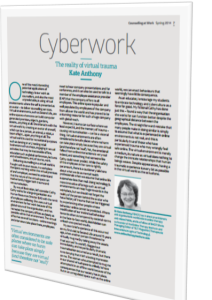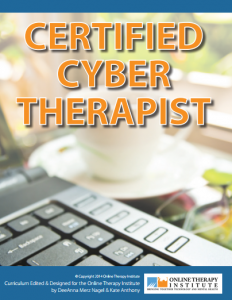 Kate continues with her regular column for the quarterly Journal of the BACP Workplace Division (http://www.bacpworkplace.org.
Kate continues with her regular column for the quarterly Journal of the BACP Workplace Division (http://www.bacpworkplace.org.
One of the most interesting potential applications of technology to our work as counsellors, and also the most unpredictable, is using virtual environments where the self is presented as an avatar – to deliver counselling services. Virtual environments, such as Second Life, are online spaces where one can build computer generated premises, objects, gardens, oceans… anything at all. One interacts with the virtual world by creating an avatar of oneself, which can be a person, an animal, a robot, a beam of light… again, anything at all. The virtual world is used for recreational purposes
such as dancing or art, hosting retail businesses such as shops, engaging in sexual activities that may be inaccessible offline, education such as global conferences, lectures and school lessons, and, of course, work.
Delivering counselling in a virtual world is fraught with its own issues. As workplace therapists working within the virtual premises of one’s employer, we need to understand that the nature of the virtual space can inadvertently trigger booth trauma and retraumatisation.
By way of illustration, let’s consider Cathy. Cathy works for a large organisation as a Human Resources Director (UK) with the remit of employee wellbeing. She uses a virtual environment for her work because of the global nature of the organisation, and has recreated the company offices as closely as possible within that environment. The virtual office has several functions – online meetings and interviews take place there, employees meet to hear company presentations and for conference, and it can also be used to talk to a member of the employee assistance provider (EAP) that the company offers to all employees. This online space is popular and well populated by employees of the company from all over the world and has proved to be a stunning resource for such a huge company with global reach.
However, trauma can surface where we least expect it, and the memory of trauma – causing retraumatisation – can be a visceral thing. Virtual environments are often considered to be safe places where no harm can take place simply because they are virtual (and therefore not ‘real’). Yet, the emotional fallout from online interactions is very real indeed, and something that someone like Cathy could never predict. While the safety of the employees in her care is rightly paramount, there is a cautionary tale here about what we do as mental health professionals when we assume that online life is somehow less than real. Using technology’s more innovative offerings such as virtual environments can reap huge rewards in the workplace, but we should not forget the reality of the person behind the avatar who has a history of trauma that can be triggered by experiencing other people whose behaviour online cannot be predicted. Where modification of our instinctual behaviour towards others is tempered by societal norms in the face-to-face world, disinhibition can unleash unexpected results.
My own brief experience of this occurred on my first visit to Second Life around 10 years ago, when another person threatened to virtually mug me (by taking away the assets I had accrued ‘in-world’). I logged out immediately, and no particularly dramatic traumatisation occurred as a result, but there is no denying that it left a lasting impression on me. The woman who attempted to mug me in our shared virtual space is unlikely to have
attempted it in an offline world because of the consequences that our society has in place. But in an unregulated space such as the online world, we can enact behaviours that seemingly have little consequence.
As an educator, I encourage my students to embrace technology and cyberculture as a force for good. My fictional Cathy has done just this – found a way that the organisation she works for can function better despite the geographical distance between the employees. The straightforward mistake that many people make in doing similar is simply to assume that what is experienced in online environments is not real, and this is particularly true of those who have experienced trauma who may wrongly feel safe online. The virtual environment is merely a medium, its nature as virtual does nothing to change the intricate relationships that human beings weave. Despite appearances, having a traumatic experience is every bit as possible
in the virtual world as the actual one.
Download the PDF: Cyberwork the Reality of Virtual Trauma


